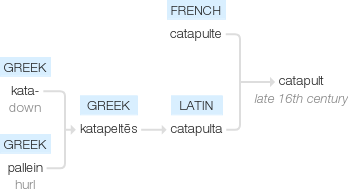Catapult
late 16th century: from French catapulte or Latin catapulta, from Greek katapeltēs, from kata- ‘down’ + pallein ‘hurl’.
wiktionary
From Middle French catapulte, from Latin catapulta, from Ancient Greek καταπέλτης(katapéltēs), from κατά(katá, “downwards, into, against”) + πάλλω(pállō, “I poise or sway a missile before it is thrown”).
etymonline
catapult (n.)
1570s, from French catapulte and directly from Latin catapulta "war machine for throwing," from Greek katapeltes, from kata "against" in reference to walls, or perhaps "through" in reference to armor (see cata-) + base of pallein "to toss, hurl" (from PIE root *pel- (5) "to thrust, strike, drive"). In ancient times a Roman military engine for throwing huge darts.
Its construction is nowhere explained with any fullness, and it is uncertain whether its action was that of a crossbow or whether springs were the propelling power. By later authors the catapult and ballista seem to be confounded. In the middle ages the name is hardly used, except where a writer is evidently seeking to give a classical form to his composition. [Century Dictionary]
As an airplane-launching device on an aircraft-carrier by 1927.
catapult (v.)
1848, "to throw with a catapult," from catapult (n.). Intransitive sense by 1928. Related: Catapulted; catapulting.
